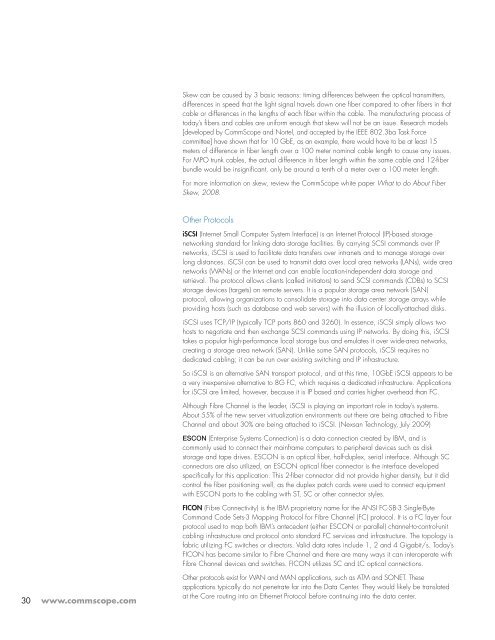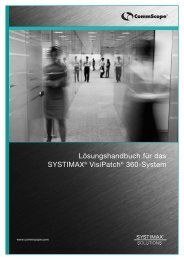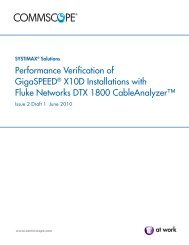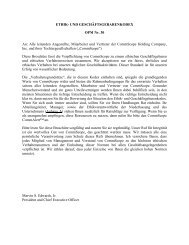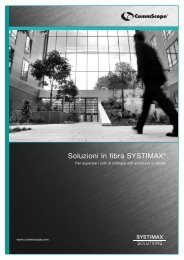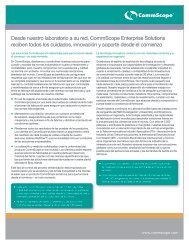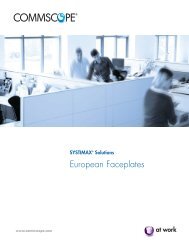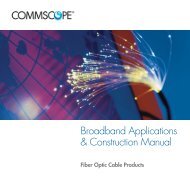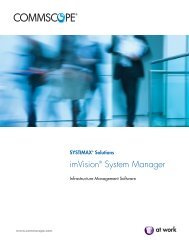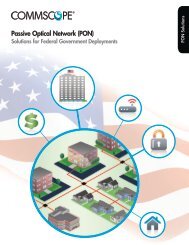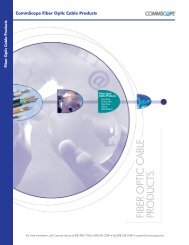CommScope® Enterprise Data Center Design Guide - Public ...
CommScope® Enterprise Data Center Design Guide - Public ...
CommScope® Enterprise Data Center Design Guide - Public ...
You also want an ePaper? Increase the reach of your titles
YUMPU automatically turns print PDFs into web optimized ePapers that Google loves.
30<br />
www.commscope.com<br />
Skew can be caused by 3 basic reasons: timing differences between the optical transmitters,<br />
differences in speed that the light signal travels down one fiber compared to other fibers in that<br />
cable or differences in the lengths of each fiber within the cable. The manufacturing process of<br />
today’s fibers and cables are uniform enough that skew will not be an issue. Research models<br />
[developed by CommScope and Nortel, and accepted by the IEEE 802.3ba Task Force<br />
committee] have shown that for 10 GbE, as an example, there would have to be at least 15<br />
meters of difference in fiber length over a 100 meter nominal cable length to cause any issues.<br />
For MPO trunk cables, the actual difference in fiber length within the same cable and 12-fiber<br />
bundle would be insignificant, only be around a tenth of a meter over a 100 meter length.<br />
For more information on skew, review the CommScope white paper What to do About Fiber<br />
Skew, 2008.<br />
Other Protocols<br />
iSCSI (Internet Small Computer System Interface) is an Internet Protocol (IP)-based storage<br />
networking standard for linking data storage facilities. By carrying SCSI commands over IP<br />
networks, iSCSI is used to facilitate data transfers over intranets and to manage storage over<br />
long distances. iSCSI can be used to transmit data over local area networks (LANs), wide area<br />
networks (WANs) or the Internet and can enable location-independent data storage and<br />
retrieval. The protocol allows clients (called initiators) to send SCSI commands (CDBs) to SCSI<br />
storage devices (targets) on remote servers. It is a popular storage area network (SAN)<br />
protocol, allowing organizations to consolidate storage into data center storage arrays while<br />
providing hosts (such as database and web servers) with the illusion of locally-attached disks.<br />
iSCSI uses TCP/IP (typically TCP ports 860 and 3260). In essence, iSCSI simply allows two<br />
hosts to negotiate and then exchange SCSI commands using IP networks. By doing this, iSCSI<br />
takes a popular high-performance local storage bus and emulates it over wide-area networks,<br />
creating a storage area network (SAN). Unlike some SAN protocols, iSCSI requires no<br />
dedicated cabling; it can be run over existing switching and IP infrastructure.<br />
So iSCSI is an alternative SAN transport protocol, and at this time, 10GbE iSCSI appears to be<br />
a very inexpensive alternative to 8G FC, which requires a dedicated infrastructure. Applications<br />
for iSCSI are limited, however, because it is IP based and carries higher overhead than FC.<br />
Although Fibre Channel is the leader, iSCSI is playing an important role in today’s systems.<br />
About 55% of the new server virtualization environments out there are being attached to Fibre<br />
Channel and about 30% are being attached to iSCSI. (Nexsan Technology, July 2009)<br />
ESCON (<strong>Enterprise</strong> Systems Connection) is a data connection created by IBM, and is<br />
commonly used to connect their mainframe computers to peripheral devices such as disk<br />
storage and tape drives. ESCON is an optical fiber, half-duplex, serial interface. Although SC<br />
connectors are also utilized, an ESCON optical fiber connector is the interface developed<br />
specifically for this application. This 2-fiber connector did not provide higher density, but it did<br />
control the fiber positioning well, as the duplex patch cords were used to connect equipment<br />
with ESCON ports to the cabling with ST, SC or other connector styles.<br />
FICON (Fibre Connectivity) is the IBM proprietary name for the ANSI FC-SB-3 Single-Byte<br />
Command Code Sets-3 Mapping Protocol for Fibre Channel (FC) protocol. It is a FC layer four<br />
protocol used to map both IBM’s antecedent (either ESCON or parallel) channel-to-control-unit<br />
cabling infrastructure and protocol onto standard FC services and infrastructure. The topology is<br />
fabric utilizing FC switches or directors. Valid data rates include 1, 2 and 4 Gigabit/s. Today’s<br />
FICON has become similar to Fibre Channel and there are many ways it can interoperate with<br />
Fibre Channel devices and switches. FICON utilizes SC and LC optical connections.<br />
Other protocols exist for WAN and MAN applications, such as ATM and SONET. These<br />
applications typically do not penetrate far into the <strong>Data</strong> <strong>Center</strong>. They would likely be translated<br />
at the Core routing into an Ethernet Protocol before continuing into the data center.


